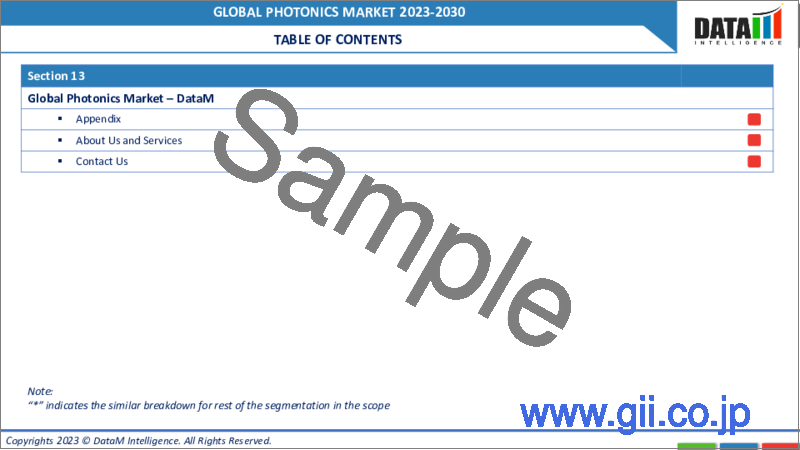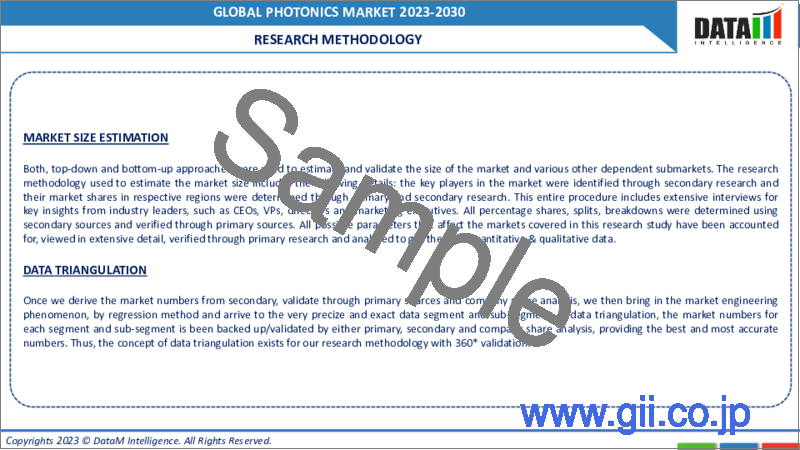|
|
市場調査レポート
商品コード
1290426
フォトニクスの世界市場- 2023-2030Global Photonics Market - 2023-2030 |
||||||
カスタマイズ可能
適宜更新あり
|
|||||||
| フォトニクスの世界市場- 2023-2030 |
|
出版日: 2023年06月12日
発行: DataM Intelligence
ページ情報: 英文 146 Pages
納期: 即日から翌営業日
|
- 全表示
- 概要
- 目次
市場の概要
フォトニクスの世界市場規模は2022年に6,665億米ドルに達し、2023年から2030年の予測期間中に5.8%のCAGRで成長し、2030年には1兆400億米ドルに達すると予測されています。
世界のフォトニクス市場は大幅な成長を遂げており、様々な産業における様々な市場動向と機会によって特徴づけられています。光通信、ヘルスケアアプリケーション、再生可能エネルギーソリューションの需要増は、顕著な市場促進要因となっています。さらに、防衛やセキュリティのアプリケーション、産業オートメーションや製造業においても、この技術に大きな市場機会があります。
市場シェアについては、主に生産技術分野が26%以上を占めています。地域別では、北米が24%を占め、最大の市場シェアを占めています。フォトニクス分野の進化に伴い、企業はこれらの動向や市場機会を活用することで、このダイナミックな業界において成長を促進し、成功を収めることができます。
市場力学
エネルギー効率の高い照明ソリューションへの需要
フォトニクスの世界市場の主要な促進要因は、エネルギー効率の高い照明ソリューションへの需要です。各国政府は、省エネルギーを推進し、二酸化炭素排出量を削減するための規制や基準の導入を進めています。その結果、発光ダイオード(LED)などのエネルギー効率の高い照明技術への移行が進んでおり、効率的で持続可能な照明ソリューションの開発においてフォトニクスは重要な役割を担っています。
各国政府も、従来の白熱電球を廃止し、LED照明システムの導入を促進する取り組みを開始しています。例えば、欧州連合は2012年に白熱電球を禁止し、フォトニクスをベースとしたLED照明製品の需要を牽引しています。
標準化された規制と認証プロセスの欠如
フォトニクスの世界市場の成長を阻害する要因のひとつに、標準化された規制や認証プロセスがないことが挙げられます。フォトニクス技術は、信頼性と安全性を確保するために、厳しい安全基準や品質基準に準拠する必要があります。地域や国によって統一された規則がないことは、市場参入の障壁となり、フォトニクスソリューションの普及の妨げとなります。こうした課題に対処するため、世界各国の政府はさまざまな取り組みや戦略を実施しています。
例えば、フォトニクス分野の研究開発を促進するための財政支援、助成金、奨励金の支給などが挙げられます。それぞれの施策は、業界関係者、研究機関、政府間の協力を促し、フォトニクス技術の商業化と普及を加速させることを目的としています。
COVID-19の影響分析
COVID-19のパンデミックは、世界のフォトニクス市場に様々な影響を及ぼしました。特定の分野では、サプライチェーンの課題やインフラプロジェクトの遅延による混乱が発生しましたが、ヘルスケア業界では、フォトニクスベースのソリューションに対する需要とサポートの増加が見られました。各国政府はヘルスケアにおけるフォトニクスの重要性を認識し、検査、治療、診断のためのフォトニクス技術の進歩にリソースを割いたのです。
パンデミック中に発売された注目すべき製品は、フォトニクス技術によって実現された携帯型診断装置や遠隔医療ソリューションを導入した企業によって、業界の回復力と革新能力を示しています。世界が回復し、新たな常態に適応していく中で、フォトニクス市場は、継続的な調査、技術革新、さまざまな産業におけるアプリケーションの増加によって、成長とさらなる進化を遂げる準備が整っています。
ロシア・ウクライナ戦争の影響分析
ロシア・ウクライナ紛争に起因する地政学的緊張は、フォトニクス業界の貿易関係や市場力学に影響を及ぼしています。各国政府は制裁や輸出制限を課し、貿易の混乱や特定市場へのアクセス制限につながっています。
さらに、ロシア・ウクライナ紛争は、国防費の増加や軍事技術の優先順位を高めることを促しました。赤外線センサー、暗視装置、レーザー照準器などのフォトニクス技術は、現代の軍事システムにおいて重要な構成要素です。
紛争は、各国が自国の能力を高め、国境を守ろうとするため、防衛分野におけるフォトニクスソリューションの需要増につながりました。
人工知能の影響分析
AIは世界のフォトニクス市場に多大な影響を与えており、これらの技術の統合は通信、ヘルスケア、製造、防衛などの産業に革命をもたらしています。AIがフォトニクス市場に与える影響は、通信業界においても顕著です。テレコム企業は、AIとフォトニクス技術を活用し、高度な光通信ネットワークを開発しています。
AIアルゴリズムによって実現されたそれぞれのネットワークは、より高いデータ伝送速度、信頼性の向上、ネットワーク管理の改善を実現しています。さらに、それぞれのイノベーションは、インターネットの高速化、シームレスな接続性、5Gやモノのインターネット(IoT)のような新興技術の促進などの基礎を築いた。
目次
第1章 調査手法と範囲
- 調査手法
- 調査目的および調査範囲
第2章 定義と概要
第3章 エグゼクティブサマリー
- アプリケーション別スニペット
- 地域別スニペット
第4章 市場力学
- 影響要因
- 促進要因
- 高速データ通信とインターネット接続に対する需要の増加
- エネルギー効率の高い照明ソリューションの需要
- 抑制要因
- 研究開発とインフラ整備に必要な初期投資の高さ
- 標準化された規制や認証プロセスの欠如
- 機会
- 影響分析
- 促進要因
第5章 産業分析
- ポーターのファイブフォース分析
- サプライチェーン分析
- 価格分析
- 法規制の分析
第6章 COVID-19の分析
第7章 アプリケーション別
- 生産技術
- 測定技術
- 医療技術
- 通信
- 照明
- 情報
- ディスプレイ
- 太陽光発電
- その他
第8章 地域別
- 北米
- 米国
- カナダ
- メキシコ
- 欧州
- ドイツ
- 英国
- フランス
- イタリア
- ロシア
- その他欧州
- 南米
- ブラジル
- アルゼンチン
- その他南米地域
- アジア太平洋地域
- 中国
- インド
- 日本
- オーストラリア
- その他アジア太平洋地域
- 中東・アフリカ地域
第9章 競合情勢
- 競合シナリオ
- 市況/シェア分析
- M&A(合併・買収)分析
第10章 企業プロファイル
- 3SP Technologies S.A.S
- 会社概要
- 製品ポートフォリオと説明
- 財務概要
- 主な発展状況
- Corning Incorporated
- Hamamatsu Photonics K.K
- Hoya Photonics, Inc.
- II-VI Incorporated
- Infinera Corporation
- Innolume GmbH
- IPG Photonics Corporation
- Koninklijke Philips N.V.
- TOPTICA Photonics AG
第11章 付録
Market Overview
The Global Photonics Market size reached US$ 666.5 billion in 2022 and is expected to reach US$ 1,040 billion by 2030, growing at a CAGR of 5.8% during the forecast period 2023-2030.
The Global Photonics Market is experiencing substantial growth and is characterized by various market trends and opportunities across different industries. The increasing demand for optical communication, healthcare applications, and renewable energy solutions are prominent market drivers. Moreover, there are significant market opportunities for the technology in defense and security applications, as well as industrial automation and manufacturing.
Regarding market share, the application segment is primarily dominated by production technology, which holds over 26% of the market share. North America has the largest market share in the regional segment, accounting for 24%. As the photonics sector evolves, businesses can capitalize on these trends and market opportunities to foster their growth and achieve success within this dynamic industry.
Market Dynamics
Demand For Energy-Efficient Lighting Solutions
A major driver for the Global Photonics Market is the demand for energy-efficient lighting solutions. Governments are increasingly implementing regulations and standards to promote energy conservation and reduce carbon emissions. As a result, there is a growing shift towards energy-efficient lighting technologies such as light-emitting diodes (LEDs) and photonics plays a vital role in developing efficient and sustainable lighting solutions.
Governments have also launched initiatives to phase out traditional incandescent bulbs and promote the adoption of LED lighting systems. For instance, the European Union banned incandescent bulbs in 2012, driving the demand for photonics-based LED lighting products.
Lack Of Standardized Regulations And Certification Processes
One aspect that hampers the growth of the global photonics market is the lack of standardized regulations and certification processes. Photonics technologies often require compliance with strict safety and quality standards to ensure reliable and safe operations. The absence of harmonized rules across regions and countries can create barriers to market entry and hinder the widespread adoption of photonics solutions. To address these challenges, governments around the world are implementing various initiatives and strategies.
For example, they are providing financial support, grants, and incentives to promote research and development in the photonics sector. The respective measures aim to encourage collaboration between industry players, research institutions, and governments to accelerate the commercialization and adoption of photonics technologies.
COVID-19 Impact Analysis
The COVID-19 pandemic had a mixed impact on the Global Photonics Market. While certain sectors experienced disruptions due to supply chain challenges and delayed infrastructure projects, the healthcare industry witnessed increased demand and support for photonics-based solutions. Governments recognized the importance of photonics in healthcare and allocated resources to advance photonics technologies for testing, treatment, and diagnostics.
Noteworthy product launches during the pandemic showcased the industry's resilience and ability to innovate, with companies introducing portable diagnostic devices and telemedicine solutions enabled by photonics technology. As the world recovers and adapt to the new normal, the photonics market is poised for growth and further advancements, driven by ongoing research, technological innovation, and increasing applications in various industries.
Russia-Ukraine War Impact Analysis
The geopolitical tensions arising from the Russia-Ukraine conflict have affected trade relationships and market dynamics in the photonics industry. Governments have imposed sanctions and export restrictions, leading to trade disruptions and limited access to certain markets.
Moreover, the Russia-Ukraine conflict has prompted increased defense spending and prioritization of military technologies. Photonics technologies, such as infrared sensors, night vision devices, and laser targeting systems, are critical components in modern military systems.
The conflict has led to an increased demand for photonics solutions in the defense sector, as countries seek to enhance their capabilities and protect their borders.
Artificial Intelligence Impact Analysis
AI has profoundly impacted the Global Photonics Market, with the integration of these technologies revolutionizing industries such as telecommunications, healthcare, manufacturing, and defense. The impact of AI on the photonics market is also evident in the telecommunications industry. Telecom companies have harnessed AI and photonics technologies to develop advanced optical communication networks.
The respective networks, enabled by AI algorithms, offer higher data transmission rates, enhanced reliability, and improved network management. Further, the respective innovation has laid the foundation for faster internet speeds, seamless connectivity, and the facilitation of emerging technologies like 5G and the Internet of Things (IoT).
Segment Analysis
The Global Photonics Market is segmented based on type, end-user and region.
High Potential Of Photonics-Based Production Technology And Government Initiatives Supporting The Segment's Grow
Photonics has emerged as a crucial field with wide-ranging applications in the telecommunications, healthcare, aerospace, and manufacturing sectors. Production technology based on photonics is employed in manufacturing processes, enabling precision, efficiency, and cost-effectiveness.
Photonics-based production technologies, such as laser cutting, welding, and 3D printing, offer significant advantages over conventional methods, offer higher precision, reduced material waste, and enhanced flexibility.
Governments worldwide recognize the potential of photonics-based production technology and have implemented policies to support its growth, thus boosting the respective segment in the global phonetics market. For instance, numerous countries have launched initiatives to promote the adoption of photonics in manufacturing processes.
Geographical Analysis
The Increasing Adoption Of Photonics Technologies Across Industries And Advancements In Technology
The increasing adoption of photonics technologies across industries has contributed to the market's expansion in North America. Photonics finds applications in diverse sectors, including telecommunications, healthcare, aerospace, and defense. For example, deploying fiber optics for high-speed internet connectivity and data transmission has driven the demand for photonic devices and systems.
In healthcare, photonics plays a crucial role in medical imaging, diagnostics, and therapy, driving the market's growth in the region. As the photonics market continues to evolve, North America is well-positioned to capitalize on the opportunities presented by technological advancements and the increasing need for photonics solutions across various sectors.
Competitive Landscape
The major global players in the market include: 3SP Technologies S.A.S, Corning Incorporated, Hamamatsu Photonics K.K, Hoya Photonics, Inc., II-VI Incorporated, Infinera Corporation, Innolume GmbH, IPG Photonics Corporation, Koninklijke Philips N.V. and TOPTICA Photonics AG.
Why Purchase the Report?
- To visualize the Global Photonics Market segmentation based on application and region and understand key commercial assets and players.
- Identify commercial opportunities by analyzing trends and co-development.
- Excel data sheet with numerous data points of photonics market-level with all segments.
- PDF report consists of a comprehensive analysis after exhaustive qualitative interviews and an in-depth study.
- Product mapping available as Excel consisting of key products of all the major players.
The Global Photonics Market Report Would Provide Approximately 45 Tables, 43 Figures And 146 pages.
Target Audience 2023
- Manufacturers/ Buyers
- Industry Investors/Investment Bankers
- Research Professionals
- Emerging Companies
Table of Contents
1. Methodology and Scope
- 1.1. Research Methodology
- 1.2. Research Objective and Scope of the Report
2. Definition and Overview
3. Executive Summary
- 3.1. Snippet by Application
- 3.2. Snippet by Region
4. Dynamics
- 4.1. Impacting Factors
- 4.1.1. Drivers
- 4.1.1.1. Increasing Demand for High-Speed Data Communication and Internet Connectivity
- 4.1.1.2. Demand For Energy-Efficient Lighting Solutions
- 4.1.2. Restraints
- 4.1.2.1. High Initial Investment Required for Research and Development and Infrastructure Setup
- 4.1.2.2. Lack Of Standardized Regulations and Certification Processes
- 4.1.3. Opportunity
- 4.1.4. Impact Analysis
- 4.1.1. Drivers
5. Industry Analysis
- 5.1. Porter's Five Force Analysis
- 5.2. Supply Chain Analysis
- 5.3. Pricing Analysis
- 5.4. Regulatory Analysis
6. COVID-19 Analysis
- 6.1. Analysis of COVID-19
- 6.1.1. Scenario Before COVID
- 6.1.2. Scenario During COVID
- 6.1.3. Scenario Post COVID
- 6.2. Pricing Dynamics Amid COVID-19
- 6.3. Demand-Supply Spectrum
- 6.4. Government Initiatives Related to the Market During Pandemic
- 6.5. Manufacturers Strategic Initiatives
- 6.6. Conclusion
7. By Application
- 7.1. Introduction
- 7.1.1. Market Size Analysis and Y-o-Y Growth Analysis (%), By Application
- 7.1.2. Market Attractiveness Index, By Application
- 7.2. Production Technology *
- 7.2.1. Introduction
- 7.2.2. Market Size Analysis and Y-o-Y Growth Analysis (%)
- 7.3. Measurement
- 7.4. Medical Technology
- 7.5. Communication
- 7.6. Lighting
- 7.7. Information
- 7.8. Display
- 7.9. Photovoltaics
- 7.10. Others
8. By Region
- 8.1. Introduction
- 8.1.1. Market Size Analysis and Y-o-Y Growth Analysis (%), By Region
- 8.1.2. Market Attractiveness Index, By Region
- 8.2. North America
- 8.2.1. Introduction
- 8.2.2. Key Region-Specific Dynamics
- 8.2.3. Market Size Analysis and Y-o-Y Growth Analysis (%), By Application
- 8.2.4. Market Size Analysis and Y-o-Y Growth Analysis (%), By Country
- 8.2.4.1. The U.S.
- 8.2.4.2. Canada
- 8.2.4.3. Mexico
- 8.3. Europe
- 8.3.1. Introduction
- 8.3.2. Key Region-Specific Dynamics
- 8.3.3. Market Size Analysis and Y-o-Y Growth Analysis (%), By Application
- 8.3.4. Market Size Analysis and Y-o-Y Growth Analysis (%), By Country
- 8.3.4.1. Germany
- 8.3.4.2. The UK
- 8.3.4.3. France
- 8.3.4.4. Italy
- 8.3.4.5. Russia
- 8.3.4.6. Rest of Europe
- 8.4. South America
- 8.4.1. Introduction
- 8.4.2. Key Region-Specific Dynamics
- 8.4.3. Market Size Analysis and Y-o-Y Growth Analysis (%), By Application
- 8.4.4. Market Size Analysis and Y-o-Y Growth Analysis (%), By Country
- 8.4.4.1. Brazil
- 8.4.4.2. Argentina
- 8.4.4.3. Rest of South America
- 8.5. Asia-Pacific
- 8.5.1. Introduction
- 8.5.2. Key Region-Specific Dynamics
- 8.5.3. Market Size Analysis and Y-o-Y Growth Analysis (%), By Application
- 8.5.4. Market Size Analysis and Y-o-Y Growth Analysis (%), By Country
- 8.5.4.1. China
- 8.5.4.2. India
- 8.5.4.3. Japan
- 8.5.4.4. Australia
- 8.5.4.5. Rest of Asia-Pacific
- 8.6. Middle East and Africa
- 8.6.1. Introduction
- 8.6.2. Key Region-Specific Dynamics
- 8.6.3. Market Size Analysis and Y-o-Y Growth Analysis (%), By Application
9. Competitive Landscape
- 9.1. Competitive Scenario
- 9.2. Market Positioning/Share Analysis
- 9.3. Mergers and Acquisitions Analysis
10. Company Profiles
- 10.1. 3SP Technologies S.A.S*
- 10.1.1. Company Overview
- 10.1.2. Product Portfolio and Description
- 10.1.3. Financial Overview
- 10.1.4. Key Developments
- 10.2. Corning Incorporated
- 10.3. Hamamatsu Photonics K.K
- 10.4. Hoya Photonics, Inc.
- 10.5. II-VI Incorporated
- 10.6. Infinera Corporation
- 10.7. Innolume GmbH
- 10.8. IPG Photonics Corporation
- 10.9. Koninklijke Philips N.V.
- 10.10. TOPTICA Photonics AG
LIST NOT EXHAUSTIVE
11. Appendix
- 11.1. About Us and Services
- 11.2. Contact Us





